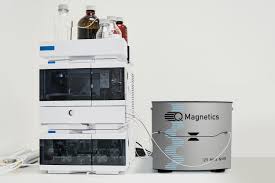Nuclear Magnetic Resonance

Nuclear Magnetic Resonance (NMR) is a powerful analytical technique used to determine the structure, dynamics, and interactions of molecules, primarily in the liquid phase. It exploits the magnetic properties of certain atomic nuclei, particularly hydrogen (^1H) and carbon (^13C), which are abundant in organic molecules.
Here’s a brief overview of how NMR works:
- Nuclear Spins: Nuclei with an odd number of protons or neutrons have a property called “spin,” which gives rise to a magnetic moment. When placed in an external magnetic field (B0), these nuclei align either parallel or antiparallel to the field.
- Energy Levels: Due to their spin, nuclei can exist in two different energy states when subjected to a magnetic field, with slightly different energies. These energy states are referred to as α (lower energy) and β (higher energy).
- Resonance: When a sample containing such nuclei is subjected to a radiofrequency (RF) pulse, the nuclei absorb energy and transition between the α and β states. The frequency at which this transition occurs is called the Larmor frequency and is proportional to the strength of the magnetic field.
- Detection: After the RF pulse is turned off, the nuclei relax back to their original states, emitting a signal that can be detected by a receiver coil. The signal is known as the Free Induction Decay (FID), which contains information about the chemical environment and motion of the nuclei.
- Analysis: By measuring the frequency and intensity of the FID signal, information about the chemical structure, molecular dynamics, and interactions within the sample can be extracted. This information is typically presented as an NMR spectrum, where peaks correspond to specific nuclei within the molecule.
NMR spectroscopy is widely used in various fields such as chemistry, biochemistry, and structural biology. It provides valuable insights into molecular structure, elucidating the connectivity of atoms within molecules, determining stereochemistry, and probing molecular interactions in solution. Additionally, advancements in NMR technology have led to applications in fields like metabolomics, drug discovery, and materials science.

